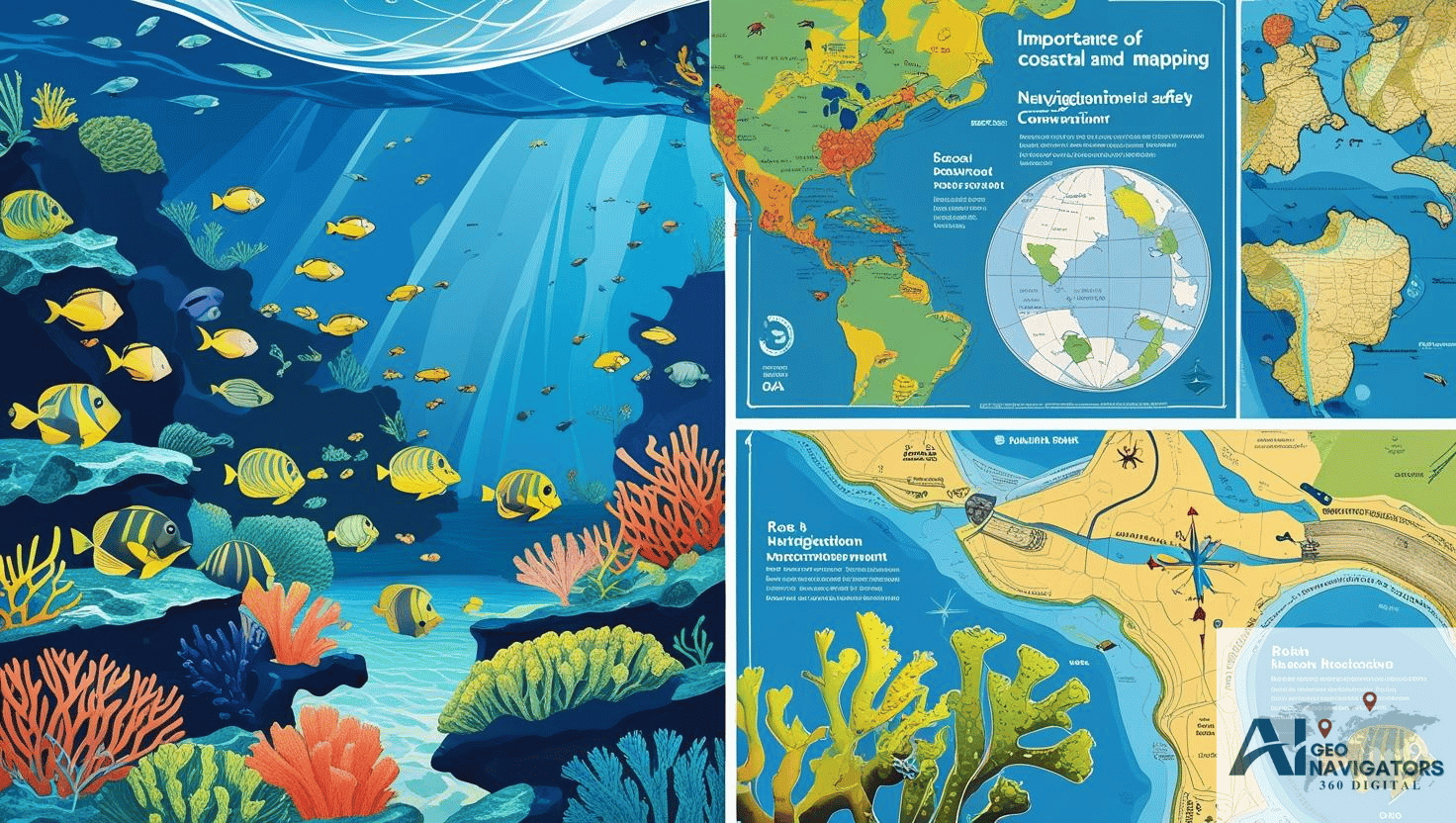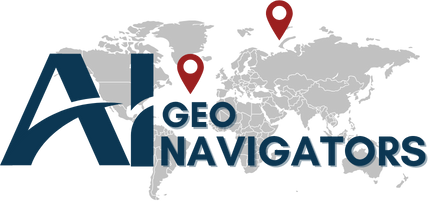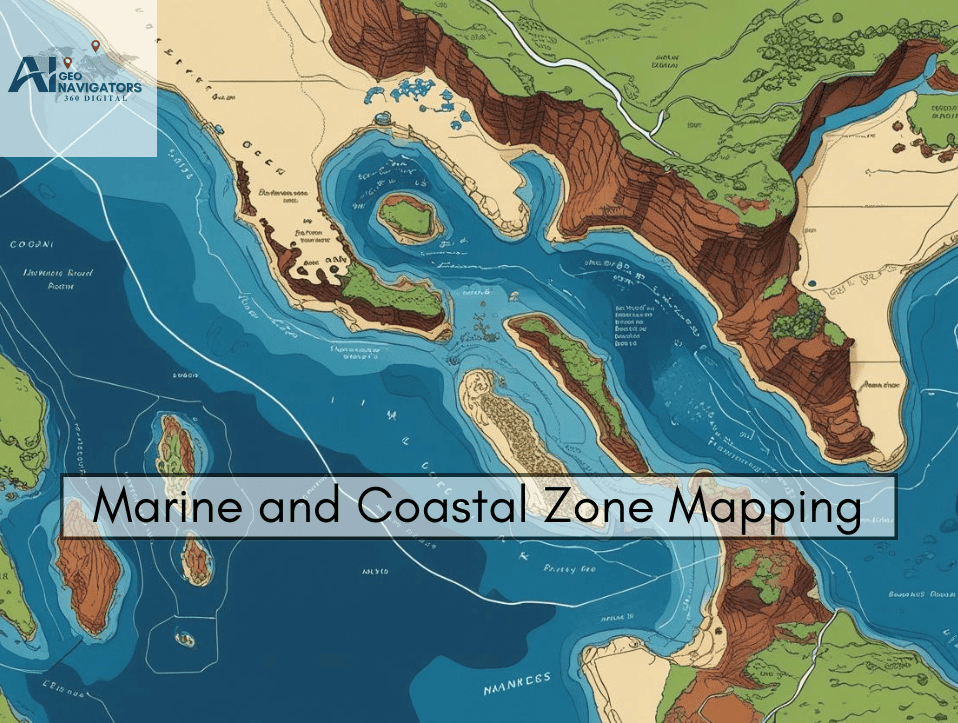Marine and Coastal Zone mapping are important to our atmosphere, budget, economy and societies. Lots of people around the world live nearby coasts, and these regions provide food, accommodation, trade paths, and natural defense from storms. But today, they are under crucial warning from contamination, unplanned growth, and climate-associated changes.
To manage and guard these valuable zones, we need strong and updated information. This is where aquatic and shoreline mapping become vital. With correct maps and monitoring tools, we can synthesize informed conclusions about how to use, defend, and reestablish these areas.
At AI Geo Navigators, we trust in using progressive technologies like Geographic Information Systems (GIS) and Remote Sensing,to support sustainable results. While we have not yet implemented an aquatic and marine mapping project, our team is well furnished and ready to provide these facilities in partnership with public and private organizations.
Why Is Marine and Coastal Zone Mapping Important?
Coastal and marine plotting and mapping is critical for understanding, defending, and sustainably handling our ocean and coastline environments. It offers the foundation for informed decision-making in zones like disaster risk drop, seaside development, and marine preservation.
Correct maps help identify vulnerable areas affected by erosion, water level rise, and cyclones, enabling appropriate response and infrastructure development.
They also mentor maintainable use of resources by marking fishing zones, shipping ways, and marine preserved areas. Mapping supports biodiversity preservation by highlighting environments like coral reefs and mangroves that need defense and protection.
Additionally, it authorizes local communities, scientists, and policymakers with data driven perceptions to ensure climate resilience, economic stability, and ecological stability. Without appropriate coastal and marine mapping, protection of our marine resources and coastal incomes becomes nearly impossible.
Environmental Monitoring

Environmental Monitoring is the process of detecting, measuring, and examining changes in natural ecologies over time. It helps notice pollution, habitat loss, and climate-related influences, providing important data for informed decision-making and sustainable source management.
Environmental Monitoring Mapping helps us perceive and monitor problems such as:
Coastal erosion (shoreline shrinking)
Coastal erosion refers to the slow wearing a way of land along the coastline due to waves, tides, and social activity. This progression can lead to the loss of beaches, damage to infrastructure, and grown vulnerability of coastal societies.
Loss of mangroves and coral reefs
Mangroves and coral reefs loss disturbs marine biodiversity and weakens natural coastal defenses. Shorelines are protected from erosion by Mangroves, while fisheries support coral reefs and tourism both are falling due to pollution, high temperatures, and unexpected and unplanned development.
Water pollution and algal blooms
When destructive and harmful substances like sewage, chemicals, and fertilizers enter coastal waters, it causes Water pollution and algal blooms to occur. This pollution leads to extreme algae growth, which lessens oxygen levels, kills marine life, and disrupts the biological balance.
Sea level rise and land submergence
Melting glaciers causes the Sea level rise and thermal expansion of seawater due to global warming causes land submersion. Low-lying coastal areas and shorelines become flooded with water as sea levels rise, threatening communities, farmland, and infrastructure with everlasting loss.
Disaster Risk Management
Involves detecting and picturing areas susceptible to natural hazards such as floods, cyclones, and tsunamis. These maps aid governments and communities plan clearance routes, build strong infrastructure, and reduce possible harm through informed risk alleviation strategies.
Mapped coastal zones help us prepare for:
Strong winds, hefty rainfall, and abrupt sea-level rise are brought by powerful coastal hazards. They can cause extensive flooding, destroy buildings or infrastructure, and threaten lives, especially in low-lying coastal areas.
- Cyclones and storm surges
- Flash floods and tsunamis
- Salinity intrusion in farmland
Marine Resource Management
Marine or aquatic maps guide appropriate planning for:
- Fishing zones
- Shipping routes
- Aquaculture locations
- Tourism regions
Climate Change Adaptation
With mapping equipment’s or tools, we can:
- Track changes in sea level
- Monitor and keep an eye on wetland harm or loss
- Design defensive infrastructure such as seawalls and mangrove barriers
Tools and Technology for Mapping
AI Geo Navigators uses tools or software like GIS software (ArcGIS, QGIS), remote sensing platforms (Sentinel-2, Landsat), and drone technologies for high-resolution coastal region mapping. These are improved algorithms and real-time dashboards for precise analysis and decision-making.
Satellite Remote Sensing
Satellite Remote Sensing uses satellites such as Sentinel-2, Landsat, and MODIS to take or capture images of the Earth’s surface at regular intervals. The changes in land use, plants, water eminence, coastal region erosion, and temperature are monitor by these satellites.
For example, Sentinel-2 delivers high-resolution images useful for mapping mangrove health and coastline changes. Landsat proposes decades of historical data to examine long-term coastal and environmental drifts.
MODIS satellite provides daily updates on sea-level surface temperature rise, algal blooms, and weather patterns. Together, these tools or equipment’s support real-time decision-making in marine and ecological management.
- Color of water changes
- Sedimentation
- Spread of Mangrove
- Coastal expansion
Geographic Information Systems (GIS)
In GIS different layers of data like land use, water depth, and pollution levels are combined on interactive digital maps.
Drones (UAVs)
High-resolution imageries of shorelines, beaches, and islands, valuable for real-time inspection are offered by Drones.
Bathymetric Mapping
We map the deepness and features of the seabed using Sonar and LiDAR. This assistances with port development, shipping protection, and ecosystem research.
Artificial Intelligence
Satellite images are analyzed in faster and more accurate ways using AI, identifying coastline changes, pollution regions, or land-water boundaries.
Challenges in Coastal Mapping
Tidal Changes:
The true boundary between land and sea can be distorted by the tides which are caused by the variations in sea level, making it hard to precisely map coastlines. Satellite imageries captured at high tide may show less land region, while low tide may depict more coastal features.
This affects uniformity in coastline delineation and habitat sorting. Precise coastal mapping needs timing data gathering with tide cycles or using tidal correction models to ensure consistent and comparable results over time.
Cloud and Water Turbidity:
Satellite views are blocked by cloud cover and muddy water. When sky is covered by the clouds, clear images of the coastal areas cannot be captured by the satellites. This makes it tough to see and map the land and water correctly.
Similarly, it’s difficult to see things under the water if the water is dirty or has too much mud, algae, or trash (called turbidity), like coral reefs or mangrove roots. These problems reduce the correctness of marine maps. To fix this, scientists often use several images or preprocessed the data using computer tools or software.
Lack of On-ground Data:
Remote sensing requires ground truthing for precision and accuracy, which is often difficult to gather in coastal areas. Without appropriate on-ground (field) data, it becomes hard to check the accuracy of satellite images and maps.
The actual condition and happening in an acrea is confirmed by the help of ground data, such as the state of mangroves, pollution levels, or variations in land use. If this crucial data is missing, the maps synthesized from satellite images might have faults or outdated. On-Field surveys are significant to support and upgrade coastal mapping and monitoring.
Data Gaps and Inconsistencies:
Multiple organizations may use different mapping techniques, making it difficult to form one complete map. Sometimes, data might be missing at certain coastal regions or is gathered at different times, utilizing different techniques.
This leads the analysis challenging, making it difficult to do time-series analysis due do the breaches and mismatches in the data and we couldn’t compare the results over time. For instance, one image might show old coastline information while another displays new expansion, triggering confusion. Constant and regularly updated data is significant for producing reliable coastal maps and making decisions.
Pakistan’s Coastal Zones: Urgent Need for Action
Pakistan has a shoreline of about 1,050 km, extending from Karachi to Gwadar. These regions include mangroves, a tidal marsh, islands, and enrich biodiversity but they face growing risks:
Mangrove loss in Sindh
Sindh’s mangrove ecologies went through a serious downfall but through coordinated restoration efforts, gotten an extraordinary rebound over the last two decades. The management should get vigilant that not just planting is important to ensure the long-term survival and durability of these critical forests because of the ongoing hydrological variations, urbanization, and habitat degradation
Pollution from industries and untreated sewage
The two of the most important contributors to environmental and ecological degradation in Pakistan are Industrial waste and untreated sewage, mainly in coastal regions. These pollutants affect aquatic life, human health, and economic doings like fisheries and tourism.
Illegal land reclamation in coastal Karachi
Illegal land reclamation in coastal region of Karachi is an increasing environmental, ecological and social threat. It not only abolishes mangroves and aquatic habitats but also heightens the susceptibility of flood risk and dislocates traditional societies. Addressing this problem needs a blend of policy enforcement, community contribution, real-time tracking, and sustainable urban planning.
No national marine GIS database exists
Despite their significance, Pakistan’s coastal regions are badly documented and mis-managed. Pakistan currently deficit a centralized national marine GIS database, resultant in uneven and inconsistent information across crucial organizations such as the Pakistan Navy Hydrographic Department, National Institute of Oceanography, SUPARCO, and provincial forest departments. This lack severely hampers coordinated aquatic spatial development, coastal region management, and ecological defense efforts.
How AI Geo Navigators Can Support Coastal Mapping
AI Geo Navigators has not yet done an aquatic mapping project; we are perfectly ready to deliver services of coastal line monitoring and mapping. AI Geo Navigators can perform a crucial role in keep up with coastal mapping through the integration of GIS and remote sensing. By using satellite imagery, our team develops high-resolution coastal line vulnerability maps to evaluate areas at danger from water level rise, erosion, and storm flows.
We also utilize drone surveys and spatial modeling techniques to examine and monitor pollution, illegal encroachments, and habitat loss. Through custom dashboards, stakeholders can picture real-time informative data and develop informed decisions for coastal region administration.
Our solutions backing disaster preparation, sea ecosystem conservation, and maintainable development planning. With our technology-driven approach, we empower organizations, governments, NGOs, and coastal societies to defend and manage brittle seaside environments.

Shoreline Change Monitoring
Satellite images are used over the time to observe erosion and land gain or loss. This aids in planning defensive actions. This information helps in recognizing vulnerable regions, supporting urban infrastructure development, and notifying policy decisions.
Our shoreline dashboards visualize these variations, allowing timely intrusions. Through continuous observing, we aid reserve environments and minimalize socio economic risks in coastal regions.
Mangrove and Coral Reef Mapping
The health and extent of the environment or ecosystem is assessed by using vegetation indices like NDVI and supervised classification. Carbon stock estimation and ecosystem service evaluation is aid by these maps. We deliver actionable insights for sea scientists, policy makers, and coastal line communities to defend these important ecosystems.
Integrated Bathymetric and Topographic Mapping
3D Coastal terrain models are built by combining elevation data and water depth. To generate accurate terrain models above and below the waterline, AI Geo Navigators influences satellite-derived bathymetry, LiDAR, sonar data, and UAV photogrammetry.
This combination keeps up coastal engineering, flood mapping, harbor expansion, and ecosystem valuation. By examining elevation variations and seabed profiles, we aid in identifying erosion patterns, sediment movement, and vulnerable infrastructure regions.
Marine Pollution Detection
To detect and plot resources of marine pollution, such as oil spills, plastic disposal, algal blooms, and unprocessed sewage discharge, AI Geo Navigators employs satellite remote sensing, UAV imagery, and AI algorithms for it. Utilizing spectral signatures and variation detection methods, we examine pollution hotspots and traces their spread over time.
Pollution levels are visualized by our GIS dashboards, allowing authorities to answer quickly and enforce principles. We also support long-term examining of industrial regions, port areas, and estuaries. To endorse cleaner, more sustainable seaside ecosystems, reduce environmental damage, keep and protect marine biodiversity by this proactive approach.
Eco Coast Monitor Dashboards
User-friendly, compensable web-based dashboards presenting real-time coastal conditions for decision-makers can be made by us. To monitor, analyze, and visualize coastal variations and dangers, AI Geo Navigators proposes an innovative, real-time platform. Satellite imagery, drone information, and sensor feeds are integrated by these dashboards to track and record the coastline erosion, mangrove damage, pollution levels, and illegal land reclamation.
The systems provide predictive insights on water-level rise, storm surge impacts, and habitat degradation, Powered by machine learning algorithms and models. Users can interrelate with dynamic maps, time-lapse visualizations, and danger alerts personalized to exact and specific coastal regions.
The system assists policymakers, researchers, and local public in making informed, data-driven choices. These dashboards are important for maintainable coastal planning, disaster alertness, and ecosystem preservation.
Potential Partnerships and Projects
We aim to collaborate with:
- Environmental and climate authorities for habitat observation.
- Disaster management agencies (e.g., NDMA) for coastal risk measurement.
- Fisheries and marine departments for resource scheduling.
- NGOs like WWF or IUCN for ecosystem protection.
We also reassure the creation of a National Coastal Observatory, where remote sensing, GIS, and AI together support long-term scheduling and planning.
Real-world Applications (Future Project Examples)
If we are given the opportunity, following projects can be implemented by us:
Karachi Coastal Erosion Tracker A web software or tool to examine and vigilant the urban planners about vanishing land along the coast.
Marine Water Quality Index Dashboard Real-time visualization of sediment transport, chlorophyll, and temperature fluctuations.
Tourism Zone Planning in Gwadar Mapping of environmentally harmless tourism and development regions using GIS.
Conclusion
Our oceans and shorelines are not just attractive landscapes but they are lifelines and means of survival that sustain and maintain our planet. They deliver food, control climate, provision biodiversity, and protect and safeguard millions from natural disasters.
Yet, these important environments face unparalleled threats from water level rising of sea, unrestricted pollution, habitat loss, and unsustainable development. To protect them, we must start with thoughtfulness and that understanding begins with specific, brainy, and continuous mapping.
At AI Geo Navigators, we are pleased to lead this work. As a Pakistan-based geospatial intellect company, we merge the power of GIS and Remote Sensing to grow innovative coastal tracking and monitoring solutions. From coastline variation detection and mangrove mapping to aquatic pollution tracing and bathymetric integration, our facilities and services are personalized to address real-world sea coast challenges with accurateness, rapidity, and foresight.
We invite local governments, global agencies, research institutions, and environmental and ecological organizations to collaborate with us as we have faith that the strong shorelines are the basis of resilient communities. Together, we can construct a future where our coastal regions are not only well plotted and mapped but also well accomplished ensuring that they continue to flourish for future generations.


No responses yet